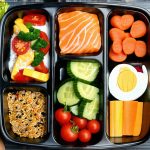Living with digestive issues – whether it’s IBS, Crohn’s & Colitis, food sensitivities, or something else entirely – can significantly impact daily life. It often means navigating a complex relationship with food, constantly assessing potential triggers and grappling with uncomfortable symptoms. Many people find themselves exhausted just thinking about meal preparation when they’re already feeling unwell. The idea of elaborate recipes or lengthy cooking processes simply becomes overwhelming. This is where the concept of “low-effort” meals truly shines – not as a compromise on nutrition, but as a vital strategy for self-care and maintaining energy levels. It’s about finding nourishing options that minimize stress both before, during, and after eating.
These aren’t necessarily recipes in the traditional sense; they are more like building blocks or templates you can adapt to your individual needs and tolerances. They prioritize easily digestible ingredients, gentle cooking methods, and minimal effort. The goal is to fuel your body without exacerbating symptoms, freeing up precious energy for other aspects of life. This article will explore some practical ideas and strategies for creating low-effort meals specifically tailored for those managing digestive issues, focusing on simplicity, nutrition, and comfort. It’s about reclaiming control over what you eat and how you feel, one easy meal at a time.
Gentle Foundations: Building Blocks for Easy Meals
The cornerstone of low-effort eating with digestive concerns is understanding your personal triggers and tolerances. What works wonderfully for one person may cause discomfort for another. However, some general principles apply to many individuals. Focusing on foods that are inherently easier to digest – those requiring less effort from the gut – can make a huge difference. This often means prioritizing well-cooked vegetables over raw ones, choosing lean proteins, and incorporating easily digestible carbohydrates like white rice or potatoes (if tolerated). Simple is truly best.
Think about textures too. Highly fibrous foods, while generally healthy, can be problematic during flare-ups. Smoothies, soups, and mashed versions of vegetables are often better choices than crunchy salads or whole grains when symptoms are present. Furthermore, limiting highly processed foods, excessive fats, and strong spices is usually beneficial. Hydration is also crucial; sipping water throughout the day aids digestion and can help prevent constipation. Don’t underestimate the power of a simple glass of water alongside your meal. If you’re experiencing ongoing issues, exploring digestive panels may provide helpful insights.
Finally, batch cooking can be a lifesaver. Preparing larger quantities of basic components like cooked rice, steamed vegetables, or shredded chicken on a good day provides ready-to-assemble meals when energy is low. This reduces decision fatigue and minimizes cooking time during symptomatic periods. It’s about proactively creating convenience for yourself. When you are having particularly difficult days, consider supportive food choices to help ease symptoms.
Simple Protein Sources
Protein is essential for healing and maintaining muscle mass, but certain protein sources are easier to digest than others. Red meat can be difficult for some, while poultry (skinless chicken or turkey) and fish (especially white fish like cod or halibut) tend to be more gentle on the digestive system. Eggs, when well-cooked, are another excellent option.
Consider these quick protein options:
– Canned tuna or salmon (in water, drained) mixed with a little mayonnaise (if tolerated) and served with crackers.
– Rotisserie chicken – easily shredded and added to soups, salads, or rice dishes.
– Tofu, gently pan-fried or steamed. Ensure it’s well-cooked to improve digestibility.
– Lentils – though they can cause gas in some individuals, properly cooked lentils are a good source of protein and fiber (start with small portions). If you experience cramping after meals, consider adjusting your protein intake.
Soothing Carbohydrates
Carbohydrates provide energy but can also be a source of digestive distress for many. The key is choosing easily digestible options and paying attention to portion sizes. White rice is often better tolerated than brown rice, as it contains less fiber. Potatoes (boiled or mashed without skin) are another good choice. Sweet potatoes, while nutritious, may cause more bloating in some individuals.
Here’s a breakdown of soothing carbohydrate choices:
1. White rice – plain boiled or with a small amount of broth for flavor.
2. Mashed potatoes – made with water or lactose-free milk and a little butter (if tolerated).
3. Gluten-free toast – with a thin spread of jam or avocado (if tolerated).
4. Oatmeal – cooked with water and topped with a small amount of fruit (if tolerated). For recovery days, comfort meals can be particularly helpful.
Vegetables: Gentle Cooking Methods are Key
Raw vegetables can be difficult to digest, especially during flare-ups. Cooking vegetables softens the fiber content, making them easier on the gut. Steaming, boiling, or roasting are all gentle cooking methods that preserve nutrients without adding excessive fat. Carrots, zucchini, and green beans are generally well-tolerated when cooked.
Here’s how to make vegetables more digestible:
– Steam or boil until tender. Avoid overcooking, as this can reduce nutrient content.
– Peel the skin off vegetables like potatoes and carrots.
– Puree cooked vegetables into a smooth soup or sauce.
– Introduce small portions of new vegetables gradually to assess tolerance. If you struggle with digestive issues even after making these adjustments, consider exploring other potential causes.
Flavor Without Flare-Ups: Gentle Seasoning & Broths
Strong spices and acidic ingredients can often aggravate digestive issues. While flavor is important, it’s best to opt for gentle seasoning options that won’t upset your stomach. Herbs like basil, oregano, and thyme are generally well-tolerated. Ginger has anti-inflammatory properties and can help soothe nausea.
Consider these flavoring strategies:
– Use low-sodium broth (chicken or vegetable) to add flavor to soups, rice, and vegetables.
– Season with a pinch of salt and pepper.
– Add a small amount of fresh herbs.
– Avoid spicy peppers, garlic, onions (unless well-tolerated), and excessive amounts of citrus juice.
Another crucial component is broth. Homemade or low-sodium store bought broth provides hydration and essential minerals while being incredibly gentle on the digestive system. Bone broth can also be incredibly soothing for some individuals due to its collagen content. It’s a versatile base for soups, stews, or simply enjoyed warm as a comforting beverage. Remember to check labels carefully for ingredients that might trigger your symptoms. Understanding microbiome testing can also help pinpoint sensitivities and optimize your diet.
The overall aim is to create meals that are nourishing, easy to digest, and require minimal effort – allowing you to focus on managing your health and well-being without being overwhelmed by food preparation. It’s about finding what works best for you and building a sustainable approach to eating that supports your digestive health.


















